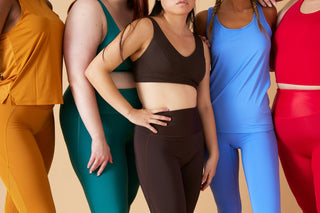Let’s face it, we all want workout clothes that look great and feel amazing but some of the most popular activewear fabrics come with hidden downsides. Polyester, nylon and spandex might wick away sweat, but they’re also prone to trapping bacteria, irritating sensitive skin and shedding microplastics every time you hit “start” on the wash cycle. In fact, NOAA data shows those tiny fibers end up in rivers, oceans and even our food chain, adding to a global pollution problem.

Here’s a quick look at what’s behind those common synthetics:
-
Polyester
-
Often treated with stain and wrinkle resistant chemicals that can leach onto your skin.
-
Holds on to sweat and odor, so your favorite tee can smell funky long after you’ve hung it up.
-
-
Nylon
- Made from petroleum, meaning a bigger carbon footprint.
-
Dyes and finishing agents can irritate delicate skin.
-
Spandex
-
Production can involve harsh solvents that impact factory workers and the surrounding environment.
-
-
-
Heavy spandex blends don’t breathe well, so sweat and bacteria linger longer.
-

Why Tencel Is a Game Changer
Tencel fabric (that’s Lenzing, lyocell and modal line) is crafted from wood pulp harvested in responsibly managed forests. Its closed loop process recycles nearly all solvents and water, cutting waste dramatically. The result? An ultra smooth, breathable fiber that’s gentle on sensitive skin, wicks moisture like a champ and keeps odors at bay without costing the planet.
Other Natural Winners
- Organic Cotton: Grown without synthetic pesticides or fertilizers so less runoff, more peace of mind.
- Bamboo Viscose: Incredibly soft and absorbent, though it pays to check how it’s processed.
-
Hemp: Tough, fast growing and thirsty for hardly any water.
Tips for Smarter Gym Wear Shopping
- Read the label: Hunt for Tencel, GOTS certified organic cotton, FSC approved wood‑based fibers or responsibly made bamboo.
- Lean on certifications: OEKO TEX®, GOTS and FSC help you spot truly sustainable pieces.
- Invest in quality: A well stitched top or pair of leggings lasts longer fewer replacements, less waste.
- Care for your clothes: Follow washing instructions and use gentle cycles to keep fibers strong and reduce microplastic shedding.
Final Thoughts
Choosing eco friendly, skin safe materials like Tencel can make a big difference in how you feel during workouts while also easing your environmental impact. Rather than settling for chemicals and microplastics, opt for high quality, sustainable fabrics that support both your health and the planet.
References
(This article is based on firsthand experience with textile products, consultations with industry experts, and credible environmental and health sources.)
